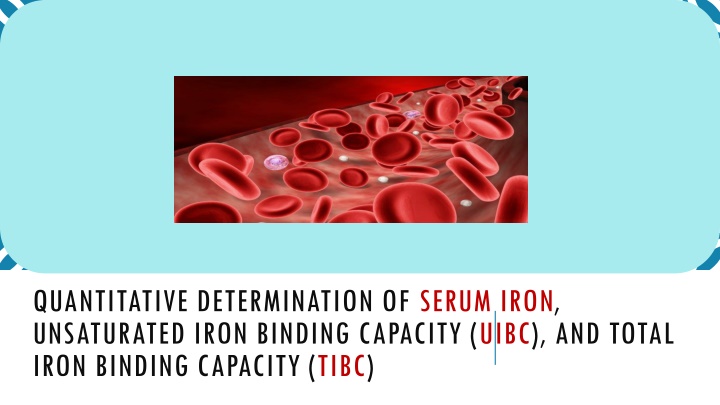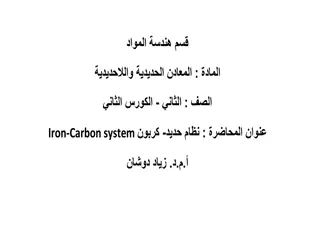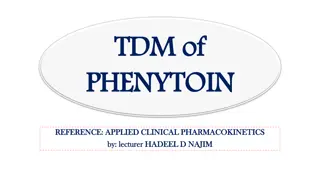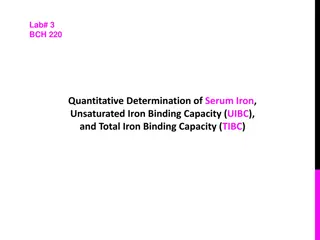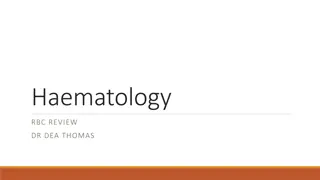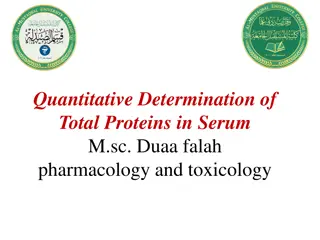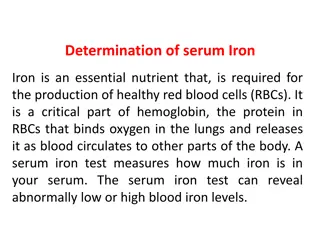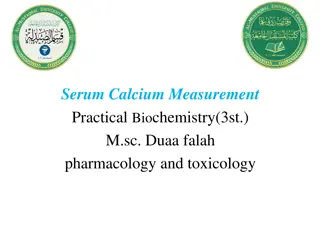Quantitative Determination of Serum Iron and Iron Binding Capacity
This article explores the quantitative determination of serum iron levels, unsaturated iron binding capacity (UIBC), and total iron binding capacity (TIBC) in the body. It discusses the distribution of iron, iron transport via transferrin, and the importance of measuring iron levels in blood to detect deficiencies or overload.
Download Presentation

Please find below an Image/Link to download the presentation.
The content on the website is provided AS IS for your information and personal use only. It may not be sold, licensed, or shared on other websites without obtaining consent from the author.If you encounter any issues during the download, it is possible that the publisher has removed the file from their server.
You are allowed to download the files provided on this website for personal or commercial use, subject to the condition that they are used lawfully. All files are the property of their respective owners.
The content on the website is provided AS IS for your information and personal use only. It may not be sold, licensed, or shared on other websites without obtaining consent from the author.
E N D
Presentation Transcript
QUANTITATIVE DETERMINATION OF SERUM IRON, UNSATURATED IRON BINDING CAPACITY (UIBC), AND TOTAL IRON BINDING CAPACITY (TIBC)
OBJECTIVES To determine the normal level of serum iron. To determine the use of this test in diagnosis of anemia (iron deficiency).
IRON IN THE BODY Iron distribution in the body 65% Iron is the metal component of haemoglobin, myoglobin, cytochromes and some proteins of the electron transport chain. 0.10% 10% 25% The total iron of an adult male is 4-5g and of a female is 3-4g. haemoglobin stored iron ( ferritin and haemosiderin ) other forms ( myoglobin, cytochromes etc. ) serum iron
IRON TRANSPORT-TRASFERRIN Transferrin Iron is carried in Fe3+ state bound to a specific iron transport protein known as transferrin. transferrin are iron-binding blood plasma glycoproteins that control the level of free iron in biological fluids It contains two specific high-affinity Fe(III) binding sites. largely synthesized by the liver Transferrin distributes iron to those tissues which have a demand for its utilization. The transferrin iron complex enters the cell through specific receptors and the iron ions are released for metabolic functions receptor
IRON TRANSPORT-TRASFERRIN When iron stores become low, transferrin levels will increase. When there is too much iron, transferrin levels are low Individuals who lack transferrin show severe hypochromic anemia and are also susceptible to bacterial and viral infections
IRON LEVEL IN BLOOD It is important to measure iron and iron-binding capacity to detect iron deficiency or overload. *Serum iron on its own provides no complete information on iron level. What tests are used ? Total iron- binding capacity Serum Iron TIBC or UIBC may be ordered along with serum iron when it appears that a person has iron deficiency or overload. These tests may be ordered when there are signs of anemia, especially when a CBC is performed and shows red blood cells that are microcytic and hypochromic and the hemoglobin and hematocrit levels are low
TOTAL IRON-BINDING CAPACITY It is a medical laboratory test that measures the blood's capacity to bind iron with transferrin. It is measuring the maximum amount of iron that it can carry, which indirectly measures transferrin It is calculated by adding serum iron and unsaturated iron binding capacity (UIBC) It is most frequently used along with a serum iron test to evaluate people suspected of having either iron deficiency anemia or iron overload (hemochromatosis)
SERUM IRON, TIBC, UIBC Total iron-binding capacity Blood Unsaturated serum iron binding capacity Serum Iron
PRINCIPLE Serum iron: The iron dissociated from its Fe-III-transferrin complex by addition of acidic buffer containing hydroxylamine which reduces the Fe(III) to Fe(II) . Then the chromogenic agent (PDTS) form a highly colored Fe(II) complex that is measured spectrophotometrically at 565nm . UIBC: Determined by adding Fe(II) to serum so that it binds to unsaturated iron binding site on transferrin . The excess Fe(II) react with PDTS to form color complex which is measured spectrophotometrically at 565nm. The difference between the amount of Fe(II) added and the amount of Fe(II) measured represent the UIBC TIBC: is determined by adding serum iron to UIBC value.
PRINCIPLE Serum Iron: PDTS Fe-III-transferrin complex Fe(II) acidic buffer Colored Fe(II) complex UIBC: Fe-III-transferrin complex + The excess Fe(II) Adding excess Fe(II) to serum Unsaturated iron binding site on transferrin PDTS Colored Fe(II) complex TIBC: is determined by adding serum iron to UIBC value.
METHOD UIBC Serum Iron Blank Standard Test Blank Standard Test Iron buffer (pH 4.5) 2.5 ml 2.5 ml 2.5 ml UIBC buffer 2 ml 2 ml 2 ml Iron Iron ------- 0.2 ml ------- ------- 0.2 ml 0.2 ml Standard Standard Sample -------- -------- 0.2 ml Sample -------- -------- 0.2 ml Water 0.2 ml -------- ------ Water 0.4 ml 0.2 ml ------
NORMAL RANGES Serum iron (50 -160 g/dl) TIBC (250 - 450 g/dl) Transferrin saturation (20 55 %)
Defect in Serum iron Serum iron is low in iron deficiency anaemia whether due to insufficient intake, malabsorbtion, blood loss or inability to retrieve storage iron. Serum iron concentration is high when marrow cannot utilize iron, hemolysis, increased absorption or defects in storage capabilities. High values are also found in severe hepatitis due to release from liver cells. Defect in Total iron binding capacity (TIBC) Increase in iron deficiency anemia Decrease in hemochromatosis, malignant or rheumatic fever.
